
Sponsored by China Society of Automotive Engineers
Published by AUTO FAN Magazine Co. Ltd.


Automotive Engineering ›› 2023, Vol. 45 ›› Issue (8): 1417-1427.doi: 10.19562/j.chinasae.qcgc.2023.08.012
Special Issue: 智能网联汽车技术专题-感知&HMI&测评2023年
Previous Articles Next Articles
Lin Hu1,Gen Li1,Fang Wang1( ),Miao Lin2,Ning Wu3
),Miao Lin2,Ning Wu3
Received:2023-02-01
Revised:2023-03-05
Online:2023-08-25
Published:2023-08-17
Contact:
Fang Wang
E-mail:wangfang83715@163.com
Lin Hu,Gen Li,Fang Wang,Miao Lin,Ning Wu. Research on Test Scenarios of Passenger Cars and Two-Wheelers at Intersections Based on CIDAS Accident Data[J].Automotive Engineering, 2023, 45(8): 1417-1427.
"
| 变量编码 | 描述 | 取值 | 选取原因 |
|---|---|---|---|
| Re_pos | 路口两轮车 对乘用车的 相对位置 | RP0 | 相对位置、速度大小、运动状态及相对速度方向用于确定预碰撞初始状态。此外,参与方的运动状态、速度和形态特征会影响测试时对两轮车的目标识别和跟踪。 |
| RP1 | |||
| RP2 | |||
| RP3 | |||
| RP4 | |||
| RP5 | |||
| RP6 | |||
| RP7 | |||
| Motion_V | 乘用车 运动状态 | 直行 | |
| 左转 | |||
| 右转 | |||
| Motion_T | 两轮车 运动状态 | 直行 | |
| 左转 | |||
| 右转 | |||
| Re_dir | 参与方相对 速度方向 | 同向 | |
| 反向 | |||
| 相互垂直 | |||
| Velocity_V | 乘用车速度 | 常数 | |
| Velocity_T | 两轮车速度 | 常数 | |
| T_Type | 两轮车类型 | 自行车 | |
| 电动两轮车 | |||
| 两轮摩托车 | |||
| Time | 时间 | 白天 | 外部环境条件影响环境感知系统,本文中两轮车测试场景提取的研究须考虑这些极端情况。 |
| 夜晚 | |||
| Weather | 天气 | 下雨 | |
| 无雨 | |||
Visual_ obstruction | 车外视野 障碍 | 有 | |
| 无 | |||
| Road_type | 路口类型 | T字路口 | 道路状况影响测试车行为决策。 |
| 十字路口 | |||
| Traffic_light | 交通灯 装配情况 | 有 | |
| 无 |
"
| 变量字段 | 取值 | 簇群 | |||||||||
|---|---|---|---|---|---|---|---|---|---|---|---|
| S0 | S1 | S2 | S3 | S4 | S5 | S6 | S7 | S8 | 总计 | ||
| T_type | 自行车 | 12 | 29 | 14 | 13 | 1 | 9 | 17 | 3 | 9 | 107 |
| 电动两轮车 | 130 | 102 | 54 | 11 | 72 | 84 | 98 | 80 | 91 | 722 | |
| 两轮摩托车 | 27 | 48 | 15 | 118 | 20 | 39 | 58 | 62 | 23 | 410 | |
| Road_type | T字路口 | 149 | 74 | 59 | 102 | 43 | 43 | 87 | 111 | 25 | 693 |
| 十字路口 | 20 | 105 | 24 | 40 | 50 | 89 | 86 | 34 | 98 | 546 | |
| Time | 夜晚 | 25 | 29 | 17 | 105 | 20 | 132 | 0 | 30 | 0 | 358 |
| 白天 | 144 | 150 | 66 | 37 | 73 | 0 | 173 | 115 | 123 | 881 | |
| Re_pos | RP0 | 1 | 4 | 3 | 12 | 1 | 3 | 0 | 0 | 0 | 24 |
| RP1 | 0 | 0 | 0 | 4 | 0 | 3 | 0 | 0 | 0 | 7 | |
| RP2 | 36 | 0 | 3 | 21 | 22 | 103 | 173 | 0 | 123 | 481 | |
| RP3 | 102 | 175 | 1 | 4 | 0 | 23 | 0 | 0 | 0 | 305 | |
| RP4 | 1 | 0 | 24 | 87 | 62 | 0 | 0 | 0 | 0 | 174 | |
| RP5 | 0 | 0 | 0 | 14 | 4 | 0 | 0 | 7 | 0 | 25 | |
| RP6 | 29 | 0 | 52 | 0 | 4 | 0 | 0 | 0 | 0 | 85 | |
| RP7 | 0 | 0 | 0 | 0 | 0 | 0 | 0 | 138 | 0 | 138 | |
| Motion_V | 直行 | 0 | 179 | 79 | 19 | 13 | 106 | 119 | 0 | 84 | 599 |
| 左转 | 9 | 0 | 0 | 121 | 74 | 22 | 54 | 7 | 18 | 305 | |
| 右转 | 160 | 0 | 4 | 2 | 6 | 4 | 0 | 138 | 21 | 335 | |
| Motion_T | 直行 | 163 | 159 | 0 | 125 | 76 | 114 | 160 | 145 | 114 | 1 056 |
| 左转 | 4 | 16 | 77 | 15 | 16 | 13 | 7 | 0 | 7 | 155 | |
| 右转 | 2 | 4 | 6 | 2 | 1 | 5 | 6 | 0 | 2 | 25 | |
| Re_dir | 同向 | 2 | 0 | 63 | 23 | 6 | 6 | 1 | 145 | 0 | 246 |
| 反向 | 30 | 4 | 20 | 106 | 87 | 3 | 0 | 0 | 0 | 250 | |
| 垂直 | 137 | 175 | 0 | 13 | 0 | 123 | 172 | 0 | 123 | 743 | |
| Weather | 无雨 | 149 | 160 | 78 | 135 | 83 | 116 | 156 | 135 | 110 | 1 122 |
| 有雨 | 20 | 19 | 5 | 7 | 10 | 16 | 17 | 10 | 13 | 117 | |
| Trafic_light | 无 | 153 | 130 | 67 | 118 | 24 | 43 | 173 | 111 | 0 | 819 |
| 有 | 16 | 49 | 16 | 24 | 69 | 89 | 0 | 34 | 123 | 420 | |
| Visual_obstruction | 无 | 143 | 144 | 78 | 130 | 80 | 122 | 130 | 136 | 104 | 1 067 |
| 有 | 26 | 35 | 5 | 12 | 13 | 10 | 43 | 9 | 19 | 172 | |
| 总计 | 169 | 179 | 83 | 142 | 93 | 132 | 173 | 145 | 123 | 1 239 | |
"
| 变量字段 | 取值 | 簇群 | ||||||
|---|---|---|---|---|---|---|---|---|
| 0 | 1 | 2 | 3 | 4 | 5 | 总计 | ||
| Re_pos | RP0 | 11 | 0 | 1 | 0 | 4 | 8 | 24 |
| RP1 | 5 | 0 | 2 | 0 | 0 | 0 | 7 | |
| RP2 | 344 | 0 | 1 | 136 | 0 | 120 | 601 | |
| RP3 | 0 | 301 | 2 | 0 | 2 | 0 | 305 | |
| RP4 | 0 | 0 | 0 | 0 | 54 | 0 | 54 | |
| RP5 | 0 | 0 | 25 | 0 | 0 | 0 | 25 | |
| RP6 | 2 | 0 | 32 | 0 | 51 | 0 | 85 | |
| RP7 | 0 | 0 | 138 | 0 | 0 | 0 | 138 | |
| Motion_V | 直行 | 301 | 194 | 0 | 0 | 104 | 0 | 599 |
| 左转 | 0 | 16 | 27 | 136 | 2 | 128 | 309 | |
| 右转 | 61 | 91 | 174 | 0 | 5 | 0 | 331 | |
| Motion_T | 直行 | 333 | 274 | 198 | 125 | 0 | 126 | 1 056 |
| 左转 | 23 | 21 | 0 | 5 | 105 | 1 | 155 | |
| 右转 | 6 | 6 | 3 | 6 | 6 | 1 | 28 | |
| Re_dir | 同向 | 5 | 0 | 168 | 10 | 62 | 1 | 246 |
| 反向 | 12 | 0 | 33 | 29 | 49 | 127 | 250 | |
| 垂直 | 345 | 301 | 0 | 97 | 0 | 0 | 743 | |
| 总计 | 362 | 301 | 201 | 136 | 111 | 128 | 1 239 | |
"
| 变量字段 | 取值 | 簇群 | |||||||||
|---|---|---|---|---|---|---|---|---|---|---|---|
| J0 | J1 | J2 | J3 | J4 | C0 | C1 | C2 | C3 | 总计 | ||
| T_type | 自行车 | 28 | 11 | 8 | 11 | 5 | 24 | 5 | 15 | 0 | 107 |
电动 两轮车 | 183 | 11 | 69 | 54 | 78 | 110 | 65 | 152 | 0 | 722 | |
两轮 摩托车 | 21 | 109 | 27 | 17 | 61 | 0 | 39 | 45 | 91 | 410 | |
| Time | 夜晚 | 32 | 116 | 22 | 11 | 18 | 27 | 109 | 0 | 23 | 358 |
| 白天 | 200 | 15 | 82 | 71 | 126 | 107 | 0 | 212 | 68 | 881 | |
| Pre_scenario | P0 | 0 | 17 | 104 | 0 | 0 | 63 | 48 | 89 | 41 | 362 |
| P1 | 154 | 11 | 0 | 0 | 0 | 44 | 19 | 49 | 24 | 301 | |
| P 2 | 0 | 17 | 0 | 0 | 144 | 3 | 8 | 24 | 5 | 201 | |
| P 3 | 0 | 13 | 0 | 82 | 0 | 11 | 7 | 20 | 3 | 136 | |
| P 4 | 57 | 16 | 0 | 0 | 0 | 12 | 8 | 16 | 2 | 111 | |
| P 5 | 21 | 57 | 0 | 0 | 0 | 1 | 19 | 14 | 16 | 128 | |
| Weather | 无雨 | 206 | 121 | 98 | 72 | 134 | 121 | 99 | 190 | 81 | 1 122 |
| 有雨 | 26 | 10 | 6 | 10 | 10 | 13 | 10 | 22 | 10 | 117 | |
| Trafic_light | 无 | 199 | 111 | 84 | 68 | 132 | 134 | 0 | 0 | 91 | 819 |
| 有 | 33 | 20 | 20 | 14 | 12 | 0 | 109 | 212 | 0 | 420 | |
Visual_ obstruction | 无 | 207 | 120 | 87 | 69 | 130 | 94 | 100 | 184 | 76 | 1 067 |
| 有 | 25 | 11 | 17 | 13 | 14 | 40 | 9 | 28 | 15 | 172 | |
| 总计 | 232 | 131 | 104 | 82 | 144 | 134 | 109 | 212 | 91 | 1 239 | |
"
| 场景编码 | 图片描述 | 致伤风险指数 | 文字描述 |
|---|---|---|---|
| J0 | 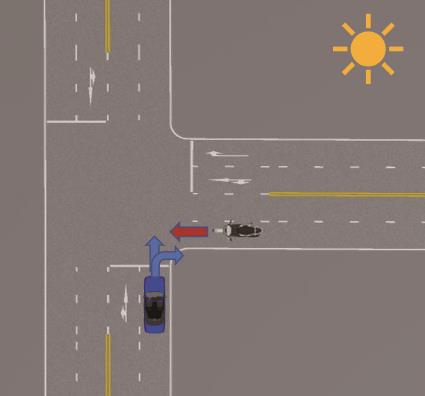 | 0.447 | 白天在无红绿灯的T字路口,一辆直行/右转的乘用车与来自右侧逆行的电动两轮车相撞(v1=20-40 km/h、v2=17-22 km/h)。 |
| J1 | 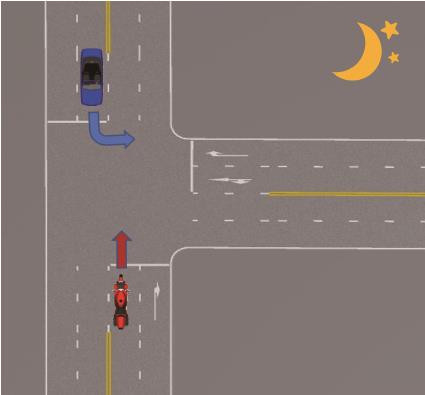 | 0.463 | 夜晚在无红绿灯的T字路口,一辆左转的乘用车与对向直行两轮摩托车相撞(v1=20-38 km/h、v2=20-40 km/h)。 |
| J2 | 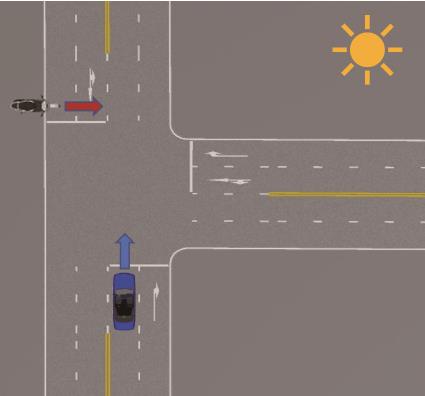 | 0.402 | 白天在无红绿灯的T字路口,一辆直行乘用车与前方从左横过马路的电动两轮车相撞(v1=20-40 km/h、v2=16-27 km/h)。 |
| J3 | 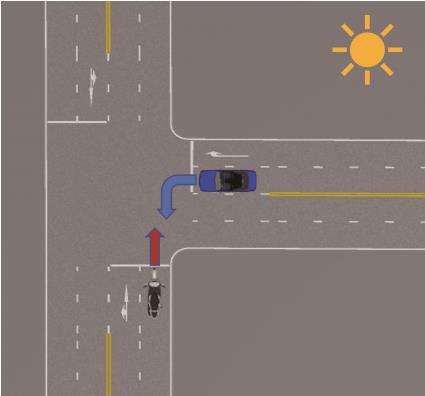 | 0.39 | 白天在无红绿灯的T字路口,一辆左转乘用车与左方直行电动两轮车相撞(v1=18-35 km/h、v2=17-30 km/h)。 |
| J4 | 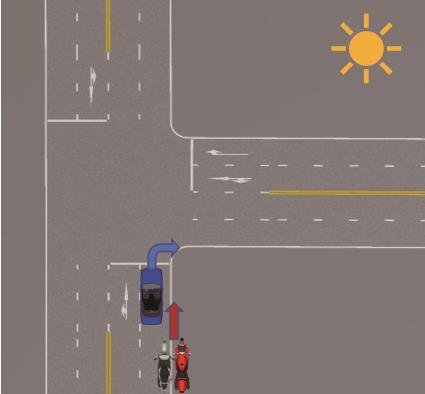 | 0.377 | 白天在无红绿灯的T字路口,右转乘用车与右后方直行两轮电动车/摩托车发生追尾(v1=15-30 km/h、v2=20-30 km/h)。 |
| C0-1 | 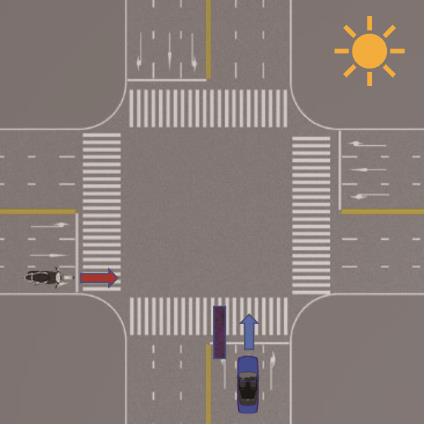 | 0.41 | 白天在无红绿灯的十字路口,直行乘用车由于视野障碍与左侧直行电动两轮车相撞(v1=20-40 km/h、v2=10-23 km/h)。 |
| C0-2 | 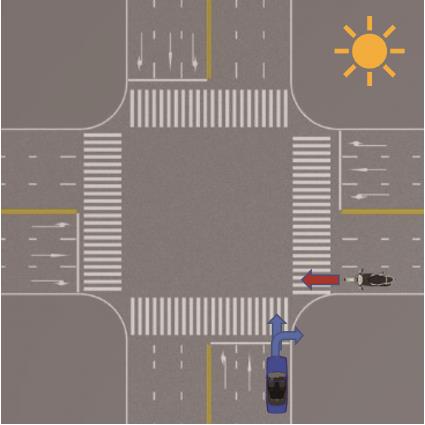 | 0.41 | 白天在无红绿灯的十字路口,一辆直行/右转的乘用车与右侧逆行的电动两轮车相撞(v1=20-40 km/h、v2=10-23 km/h)。 |
| C1 |  | 0.474 | 夜晚在有红绿灯的十字路口,直行乘用车与左侧直行两轮电动车/摩托车垂直相撞(v1=23-42 km/h、v2=20-30 km/h)。 |
| C2 |  | 0.443 | 白天在有红绿灯的十字路口,直行乘用车与左侧直行两轮电动车垂直相撞(v1=20-40 km/h、v2=15-30 km/h)。 |
| C3 | 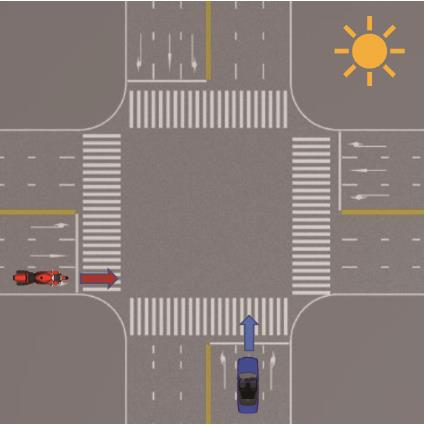 | 0.495 | 白天在无红绿灯的十字路口,直行乘用车与左侧直行两轮摩托车垂直相撞(v1=20-40 km/h、v2=25-40 km/h)。 |
| 1 | 国家统计局. 2020年年度道路交通事故统计数据[EB/OL]. http: //www. stats. gov. cn. |
| 2 | HU L, HU X, WANG J, et al. Casualty risk of e-bike rider struck by passenger vehicle using China in-depth accident data[J]. Traffic Injury Prevention, 2020, 21(4): 283-287. |
| 3 | HADJIDIMITRIOU N S, LIPPI M, DELL’AMICO M, et al. Machine learning for severity classification of accidents involving powered two wheelers[J]. IEEE Transactions on Intelligent Transportation Systems, 2019, 21(10): 4308-4317. |
| 4 | HU L, BAO X, LIN M, et al. Research on risky driving behavior evaluation model based on CIDAS real data[J]. Proceedings of the Institution of Mechanical Engineers, Part D: Journal of Automobile Engineering, 2021, 235(8): 2176-2187. |
| 5 | CHARRAN R S, DUBEY R K. Two-wheeler vehicle traffic violations detection and automated ticketing for indian road scenario[J]. IEEE Transactions on Intelligent Transportation Systems, 2022, 23(11): 22002-22007. |
| 6 | HU L, TIAN Q, ZOU C, et al. A study on energy distribution strategy of electric vehicle hybrid energy storage system considering driving style based on real urban driving data[J]. Renewable and Sustainable Energy Reviews, 2022, 162: 112416. |
| 7 | 朱冰, 张培兴, 赵健, 等. 基于场景的自动驾驶汽车虚拟测试研究进展[J]. 中国公路学报, 2019, 32(6): 1-19. |
| ZHU Bing, ZHANG Peixing, ZHAO Jian, et al. Review of scenario-based virtual validation methods for automated vehicles[J]. China Journal of Highway and Transport, 2019, 32(6): 1-19. | |
| 8 | Euro NCAP. Test protocol AEB VRU systems[EB/OL]. Available: https://cdn.euroncap.com/media/75436/euro-ncap-aeb-lss-vru-test-protocol-v43.pdf. |
| 9 | C-NCAP. Testing protocol for active security system[EB/OL]. Available: https://www.c-ncap.org.cn/download. |
| 10 | CHANG F, HAQUE M M, YASMIN S, et al. Crash injury severity analysis of E-Bike riders: a random parameters generalized ordered probit model with heterogeneity in means[J]. Safety Science, 2022, 146: 105545. |
| 11 | HU L, LI H, YI P, et al. Investigation on AEB key parameters for improving car to two-wheeler collision safety using in-depth traffic accident data[J]. IEEE Transactions on Vehicular Technology, 2022. |
| 12 | ULBRICH S, MENZEL T, RESCHKA A, et al. Defining and substantiating the terms scene, situation, and scenario for automated driving[C]. 2015 IEEE 18th International Conference on Intelligent Transportation Systems. IEEE, 2015: 982-988. |
| 13 | 胡林, 易平, 黄晶, 等. 基于真实事故案例的自动紧急制动系统两轮车测试场景研究[J]. 汽车工程, 2018, 40(12): 1435-1446. |
| HU L, YI P, HUANG J, et al. A research on test scenes of two-wheeled vehicles for automatic emergency braking system based on real accident cases[J]. Automot. Eng., 2018, 40(12): 1435-1446. | |
| 14 | PAN D, HAN Y, JIN Q, et al. Study of typical electric two‐wheelers pre-crash scenarios using K-medoids clustering methodology based on video recordings in China[J]. Accident Analysis & Prevention, 2021, 160: 106320. |
| 15 | SUI B, LUBBE N, BÄRGMAN J. A clustering approach to developing car-to-two-wheeler test scenarios for the assessment of automated emergency braking in China using in-depth Chinese crash data[J]. Accident Analysis & Prevention, 2019, 132: 105242. |
| 16 | CAO Y, XIAO L, DONG H, et al. Typical pre-crash scenarios reconstruction for two-wheelers and passenger vehicles and its application in parameter optimization of AEB system based on NAIS database[C]. 26th International Technical Conference on the Enhanced Safety of Vehicles (ESV), 2019. |
| 17 | ATALAR D, THOMAS P. Powered two-wheeler crash scenario development[J]. Accident Analysis & Prevention, 2019, 125: 198-206. |
| 18 | HU W, XU X, ZHOU Z, et al. Mining and comparative analysis of typical pre-crash scenarios from IGLAD[J]. Accident Analysis & Prevention, 2020, 145: 105699. |
| 19 | SANDER U, LUBBE N. The potential of clustering methods to define intersection test scenarios: assessing real-life performance of AEB[J]. Accident Analysis & Prevention, 2018, 113: 1-11. |
| 20 | NITSCHE P, THOMAS P, STUETZ R, et al. Pre-crash scenarios at road junctions: a clustering method for car crash data[J]. Accident Analysis & Prevention, 2017, 107: 137-151. |
| 21 | CRAMER H. Mathematical methods of statistics[M]. Princeton University Press, 1999. |
| 22 | HAMMING R W. Error detecting and error correcting codes[J]. The Bell System Technical Journal, 1950, 29(2): 147-160. |
| 23 | VIJAY R, MAHAJAN P, KANDWAL R. Hamming distance based clustering algorithm[J]. International Journal of Information Retrieval Research (IJIRR), 2012, 2(1): 11-20. |
| 24 | ROUSSEEUW P J. Silhouettes: a graphical aid to the interpretation and validation of cluster analysis[J]. Journal of Computational and Applied Mathematics, 1987, 20: 53-65. |
| 25 | HAN J, PEI J, TONG H. Data mining: concepts and techniques[M]. Morgan Kaufmann, 2022. |
| 26 | HU L, HU X, WAN J, et al. The injury epidemiology of adult riders in vehicle-two-wheeler crashes in China, Ningbo, 2011-2015[J]. Journal of Safety Research, 2020, 72: 21-28. |
| 27 | SANTOS K, DIAS J P, AMADO C, et al. Risk factors associated with the increase of injury severity of powered two wheelers road accidents victims in Portugal[J]. Traffic Injury Prevention, 2021, 22(8): 646-650. |
| 28 | 工业与信息化部. 电动自行车安全技术规范: GB 17761—2018 [S]. 2019. |
| Ministry of Industry and Information Technology. Safety technical specification for eletric bicycle:GB 17761—2018[S]. 2019. | |
| 29 | HU L, ZHONG Y, HAO W, et al. Optimal route algorithm considering traffic light and energy consumption[J]. IEEE Access, 2018, 6: 59695-59704. |
| 30 | ZADOBRISCHI E, COSOVANU L M, DIMIAN M. Traffic flow density model and dynamic traffic congestion model simulation based on practice case with vehicle network and system traffic intelligent communication[J]. Symmetry, 2020, 12(7): 1172. |
| 31 | SUN C, GUANETTI J, BORRELLI F, et al. Optimal eco-driving control of connected and autonomous vehicles through signalized intersections[J]. IEEE Internet of Things Journal, 2020, 7(5): 3759-3773. |
| 32 | XIAO J, HUANG Z, LI Y, et al. Study on the occlusion of the visibility window on highway exit ramps[J]. The International Journal of Electrical Engineering & Education, 2021: 0020720921999771. |
| [1] | Yong Han,Liya Lin,Yong He,Di Pan,Hongyu Cai,Qian Peng,Hao Feng. Research on the Effects of Emergent Avoidance Postures of Electric Two-wheeler Riders on Their Injury Risk [J]. Automotive Engineering, 2022, 44(5): 764-770. |
| [2] | Zhu Bing, Zhang Peixing, Zhao Jian. Clustering Evaluation Method of Autonomous Driving Safety for Multi-dimensional Logical Scenario [J]. Automotive Engineering, 2020, 42(11): 1458-1463. |
| [3] | Hu Lin, Yi Ping, Huang Jing, Zhang Xin, Lei Zhengbao. A Research on Test Scenes of Two-wheeled Vehicles for Automatic Emergency Braking System Based on Real Accident Cases [J]. , 2018, 40(12): 1435-1446. |